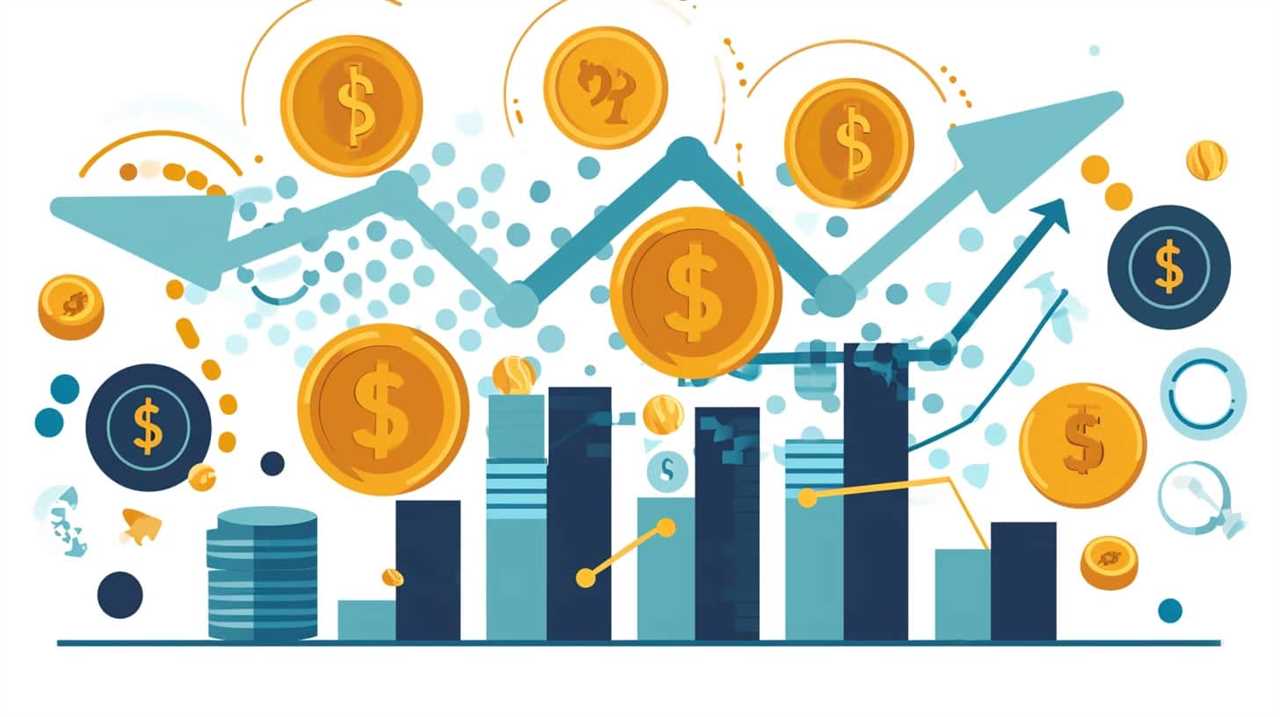In our quest for mastery in economics, we have uncovered a powerful concept known as Nash Equilibrium. Like a guiding star in the vast economic universe, Nash Equilibrium allows us to navigate the complex interplay of decisions and strategies.
In this guide, we present 14 tips that will help us leverage Nash Equilibrium to our advantage. By applying game theory principles, identifying dominant strategies, and analyzing payoff matrices, we can uncover pure strategy equilibriums and maximize our individual utility.
We will also explore the delicate balance between short-term and long-term goals, adapt to changing situations, and discover how Nash Equilibrium can be applied to real-world scenarios.
Get ready to unlock the secrets of economic success through the power of Nash Equilibrium!

Key Takeaways
- Nash Equilibrium is a concept in game theory that helps businesses analyze competitive markets and strategic interactions with competitors.
- Dominant strategies, which yield the highest payoff regardless of other players’ actions, can significantly impact the overall outcome of a game.
- The payoff matrix is essential in identifying dominant strategies and determining Nash equilibrium.
- Game theory provides insights into optimal decision-making, market behavior, and strategic decision-making in economics.
Understanding Nash Equilibrium
To understand Nash Equilibrium, we must start by examining its principles and applications in economic theory. Nash Equilibrium is a concept in game theory that aims to find optimal strategies for decision-making in competitive situations. It was developed by mathematician John Nash and has found wide-ranging applications in fields such as economics, political science, and business.
In economics, Nash Equilibrium is used to analyze how individuals or firms make decisions in strategic interactions. It provides a framework for understanding the outcomes that arise when multiple players in a game each choose their strategies independently. By identifying the strategies that lead to equilibrium, economists can predict the behavior of individuals and firms in various economic scenarios.
The concept of Nash Equilibrium has particularly significant game theory applications in business. It helps businesses analyze competitive markets, pricing decisions, and strategic interactions with competitors. By identifying the Nash Equilibrium in a market, firms can determine the optimal strategy to maximize their profits and gain a competitive advantage.
Applying Game Theory Principles
We can apply game theory principles to analyze strategic interactions and make optimal decisions in economics. By understanding game theory and its concepts, we can enhance our strategic decision-making abilities and gain a competitive edge in various economic scenarios. Here are three key ways game theory principles can be applied:

- Predicting outcomes: Game theory allows us to predict the possible outcomes of strategic interactions by analyzing the choices and preferences of the involved parties. By modeling these interactions mathematically, we can identify the equilibrium points where no player has an incentive to deviate from their chosen strategy.
- Analyzing competitive behavior: Game theory helps us understand how players behave in competitive markets. By studying the strategies and actions of firms, we can determine the optimal decisions that will maximize their profits and market share.
- Negotiation and bargaining: Game theory provides insights into negotiation and bargaining processes. By analyzing the preferences, power dynamics, and potential outcomes, we can develop strategies to achieve favorable outcomes in negotiations.
Applying game theory principles in economics empowers us to make informed decisions by considering the strategic interactions and incentives at play. It allows us to navigate complex economic situations and optimize our choices for maximum benefit.
Identifying Dominant Strategies
When it comes to understanding dominant strategies in economics, it’s important to first define what a dominant strategy is.
A dominant strategy is a strategy that yields the highest payoff regardless of the actions taken by other players.
To identify dominant strategies, one must carefully analyze the payoffs associated with each possible strategy and determine which strategy provides the best outcome.

The presence of dominant strategies can have a significant impact on the overall outcome of a game, as players who identify and play their dominant strategies can gain a competitive advantage.
Dominant Strategy Definition
In the realm of economics, identifying dominant strategies is crucial for leveraging Nash equilibrium. Dominant strategy identification is a key concept in strategic decision making analysis, as it allows us to determine the best course of action for a player, regardless of the choices made by other players.
Here are three important points to consider when defining dominant strategies:
- A dominant strategy is one that yields the highest payoff for a player, regardless of the choices made by other players.
- It provides a clear and optimal decision-making framework, eliminating any uncertainty or ambiguity.
- Dominant strategies are often identified through careful analysis of the game’s payoffs and strategic interactions.
By understanding and finding dominant strategies, economists can make informed predictions about how players will behave in a given situation. This knowledge is essential for achieving a stable and efficient Nash equilibrium.

Now let’s delve into the process of finding dominant strategies.
Finding Dominant Strategies
To identify dominant strategies, we must delve into the process of finding them through careful analysis of the game’s payoffs and strategic interactions. In strategic decision making analysis, a dominant strategy refers to a choice that yields the best outcome regardless of the actions taken by other players. It’s a strategy that a rational player would always choose, as it provides the highest payoff irrespective of the choices made by other players.
Identifying dominant strategies involves comparing the payoffs associated with different strategies and determining which strategy consistently yields the highest payoff. By identifying dominant strategies, we can gain insights into the optimal choices that players should make in a game. Understanding the concept of dominant strategies is crucial as it helps us analyze the impact of these strategies on the overall outcome of the game.
Impact of Dominant Strategies
We can analyze the impact of dominant strategies by assessing their influence on the overall outcome of the game. Dominant strategies have significant implications in game theory applications and can greatly affect the players’ decisions and payoffs.

Here are some key points to consider:
- Dominant strategies provide a clear advantage to the player who adopts them, regardless of the choices made by other players.
- Identifying dominant strategies allows players to make rational decisions based on their best interests, maximizing their potential gains.
- The presence of dominant strategies can lead to predictable outcomes and stable equilibriums in a game.
Understanding the impact of dominant strategies is crucial in analyzing the dynamics of a game and predicting its outcome. By identifying dominant strategies, we can gain insights into the players’ behavior and make informed decisions.
Now, let’s delve deeper into the topic by analyzing the payoff matrix.
Analyzing Payoff Matrix
When analyzing a payoff matrix, we must focus on two key points: identifying dominant strategies and determining the Nash equilibrium.

By identifying dominant strategies, we can determine the best course of action for each player, maximizing their payoff.
Determining the Nash equilibrium allows us to find the stable outcome where no player has an incentive to deviate from their chosen strategy.
These two points are crucial in understanding and leveraging the payoff matrix in economics.
Dominant Strategy Identification
The identification of a dominant strategy involves analyzing the payoff matrix to determine the most advantageous decision for all players involved. In game theory strategies, a dominant strategy is one that yields the highest payoff regardless of the choices made by other players.

Here are three key points to consider when identifying a dominant strategy:
- Analyze the payoff matrix: Examine the outcomes for each player based on different choices and identify the strategy that consistently provides the highest payoffs.
- Consider strategic decision making: Take into account the rationality and self-interest of each player when determining the dominant strategy.
- Evaluate the stability of the strategy: Assess whether the dominant strategy remains optimal even if other players change their choices.
Understanding dominant strategies is crucial in strategic decision making. By identifying the dominant strategy, players can make informed decisions that maximize their own gains.
Now, let’s delve into the next section to explore the determination of Nash equilibrium.
Nash Equilibrium Determination
To determine the Nash equilibrium in game theory, we analyze the payoff matrix to identify the optimal strategy for all players involved. The payoff matrix represents the outcomes and corresponding payoffs for each player’s strategies. By examining the matrix, we can identify the combination of strategies where no player has an incentive to deviate from their chosen strategy, leading to a stable equilibrium.

In strategic decision-making analysis, the Nash equilibrium serves as a benchmark for rational behavior. It represents a state where no player can improve their payoff by unilaterally changing their strategy, given the strategies chosen by the other players. This concept is essential in understanding the dynamics of competitive situations and predicting outcomes in various fields, such as economics, politics, and biology.
Finding Pure Strategy Equilibrium
Our approach to finding pure strategy equilibrium in economics involves leveraging the principles of Nash equilibrium. Pure strategy optimization is an essential concept in game theory applications, allowing us to determine the best course of action for each player in a game.
To effectively find pure strategy equilibrium, we follow these steps:
- Identify the players: First, we need to identify all the players involved in the game. This could be individuals, firms, or countries, depending on the context of the economic situation.
- Define the strategies: Next, we define the possible strategies that each player can choose from. These strategies can be as simple as ‘cooperate’ or ‘defect’ in a prisoner’s dilemma game or more complex in a multi-player game.
- Analyze payoffs: We then analyze the payoffs associated with each combination of strategies chosen by the players. Payoffs represent the outcomes or rewards that each player receives based on their strategy choices.
By analyzing the payoffs and considering the strategies chosen by each player, we can determine the pure strategy equilibrium, where no player has an incentive to deviate from their chosen strategy. This equilibrium provides valuable insights into the optimal decision-making process in economic interactions.

Transitioning into the next section, exploring mixed strategy equilibrium, allows us to delve further into the complexities of game theory and uncover additional possibilities for decision-making in economics.
Exploring Mixed Strategy Equilibrium
Moving on to the topic of exploring mixed strategy equilibrium, we can further delve into the complexities of game theory and uncover additional possibilities for decision-making in economics. In mixed strategy equilibrium, players choose their strategies based on probabilities rather than making deterministic choices. This introduces a level of uncertainty and randomness to the decision-making process.
Mixed strategy optimization involves finding the optimal probability distribution for each player’s strategies, taking into account the payoffs and the likelihood of opponents’ strategies. It aims to maximize the expected utility for each player. By considering all possible mixed strategies and their corresponding outcomes, economists can determine the equilibrium point where no player has an incentive to deviate from their chosen strategy.
Equilibrium stability is an important concept in mixed strategy equilibrium. It refers to the stability of the equilibrium point against small perturbations or changes in strategies. A stable equilibrium is one where players have no reason to change their strategies, even if they’re aware of the strategies chosen by their opponents.

Understanding mixed strategy equilibrium allows economists to analyze complex situations where players have multiple possible strategies. By optimizing their mixed strategies and ensuring equilibrium stability, decision-makers can make informed choices that maximize their expected utility.
Considering interactions and reactions, we can further explore how players’ strategies affect each other in the game theory framework.
Considering Interactions and Reactions
When considering interactions and reactions in the context of leveraging Nash equilibrium in economics, game theory applications and strategic decision-making analysis become crucial.
Game theory provides a framework for understanding how individuals or organizations make decisions in strategic situations where the outcomes depend on the choices of others.

Game Theory Applications
Game theory applications, such as analyzing strategic interactions and predicting reactions, play a crucial role in understanding economic dynamics. By employing game theory, economists can gain valuable insights into complex decision-making processes and anticipate how individuals and organizations will respond in various situations.
Here are three key ways game theory applications contribute to strategic decision-making analysis:
- Strategic Interactions: Game theory provides a framework for analyzing how individuals and groups interact strategically, considering the choices and actions of other players. This allows economists to understand the dynamics of competitive markets, negotiations, and conflicts.
- Predicting Reactions: By modeling the expected reactions of players in a game, economists can predict how individuals will respond to different incentives and scenarios. This predictive power is valuable in understanding market behavior, policy outcomes, and strategic decision-making.
- Optimal Strategies: Game theory helps identify optimal strategies for different players in a game, taking into account the actions and potential reactions of other participants. This analysis assists in determining the most advantageous course of action, balancing risk and reward, and maximizing individual or collective welfare.
Strategic Decision-Making Analysis
To analyze strategic decision-making, we consider the interactions and reactions of economic agents. Strategic decision-making techniques play a crucial role in shaping the outcomes of businesses and industries. One powerful tool in this analysis is game theory, which provides a framework to understand how agents strategically interact with each other to maximize their own outcomes.
By using game theory applications in business, we can model and analyze various scenarios to determine the best course of action. This involves examining the decisions made by different players, their potential strategies, and the possible reactions to those strategies. Through this analysis, we can identify optimal strategies and predict the outcomes of strategic decisions.

Understanding the interactions and reactions of economic agents is key to making informed decisions and achieving success in a competitive environment.
Now, let’s transition into the subsequent section about recognizing cooperation vs. competition.
Recognizing Cooperation Vs. Competition
As economists, we must actively distinguish between cooperative and competitive dynamics in order to effectively leverage Nash Equilibrium. Cooperation dynamics play a crucial role in understanding how individuals or firms work together to achieve mutually beneficial outcomes. On the other hand, recognizing competitive advantage enables us to analyze how individuals or firms strive to outperform each other in order to gain a larger share of the market. This distinction is essential in understanding the intricate balance between cooperation and competition that shapes economic interactions. By understanding both cooperative and competitive dynamics, we can effectively determine the optimal strategies for different situations. Furthermore, uncovering the secrets of comparative advantage allows us to identify the unique strengths that can be leveraged to maximize success in the marketplace.
To recognize cooperation dynamics:

- Look for situations where individuals or firms work together to achieve a common goal.
- Identify instances where cooperation leads to improved outcomes for all parties involved.
- Analyze the strategies used to foster cooperation and maintain long-term relationships.
To recognize competitive advantage:
- Identify situations where individuals or firms are trying to gain a competitive edge over others.
- Look for instances where individuals or firms are providing unique products or services.
- Analyze the strategies used to gain a competitive advantage, such as cost leadership or differentiation.
Understanding the distinction between cooperation and competition is essential for leveraging Nash Equilibrium effectively. By recognizing cooperation dynamics and competitive advantage, economists can develop strategies that maximize outcomes for all parties involved.
Assessing Risk and Reward
Assessing the potential risks and rewards is crucial in leveraging Nash Equilibrium effectively in economics. In order to make informed decisions, it is essential to have a clear understanding of the risks involved and the potential rewards that can be gained. By evaluating investment opportunities and assessing risk management strategies, individuals and businesses can optimize their decision-making process.
To better understand the importance of assessing risk and reward, let’s take a look at the following table:

| Risk Assessment | Reward Evaluation |
|---|---|
| Identify potential risks and uncertainties | Analyze potential gains and benefits |
| Evaluate the likelihood of risks occurring | Determine the potential return on investment |
| Develop risk management strategies | Identify opportunities for growth and profitability |
Assessing risk management involves identifying potential risks and uncertainties that may impact the success of an investment. This includes evaluating the likelihood of these risks occurring and developing strategies to mitigate them. On the other hand, evaluating investment opportunities requires analyzing the potential gains and benefits that can be achieved. This involves determining the potential return on investment and identifying opportunities for growth and profitability.
In leveraging Nash Equilibrium, it is important to consider both the potential risks and rewards. By carefully assessing risk management and evaluating investment opportunities, individuals and businesses can make informed decisions that maximize their chances of success.
Evaluating Potential Outcomes
We need to consider the potential outcomes when leveraging Nash Equilibrium in economics. Evaluating outcomes is crucial in strategic decision making, as it allows us to anticipate the consequences of our actions and make informed choices.
Here are three key factors to consider when evaluating potential outcomes:

- Payoff Matrix: Analyzing the payoff matrix helps us understand the potential gains and losses associated with different strategies. By examining the payoffs for each player in various scenarios, we can identify the equilibrium where no player has an incentive to deviate from their chosen strategy.
- Dominant Strategies: Identifying dominant strategies is essential in evaluating potential outcomes. A dominant strategy is one that yields the highest payoff regardless of the actions taken by other players. By selecting a dominant strategy, we can maximize our own gains in any situation.
- Game Dynamics: Understanding the dynamics of the game is crucial in evaluating potential outcomes. By considering how players interact and respond to each other’s actions, we can anticipate the strategic moves that are likely to occur. This helps us evaluate the potential outcomes and adjust our strategies accordingly.
Maximizing Individual Utility
When it comes to maximizing individual utility, we need to consider the trade-off between personal satisfaction and competition.
In our rational decision-making process, we strive to make choices that will maximize our own well-being. However, it’s important to strike a balance between self-interest and cooperation, as our actions can have ripple effects on others and ultimately impact our own outcomes.
Personal Satisfaction Vs. Competition
Regularly, individuals in a competitive environment strive to maximize their own utility while balancing personal satisfaction and the pressures of competition. Achieving personal satisfaction in a competitive setting can be challenging, as it requires individuals to navigate the fine line between self-improvement and collaborative mindset.
Here are three key considerations:

- Embrace personal growth: By focusing on personal development, individuals can enhance their skills and knowledge, giving them a competitive edge. This can lead to increased personal satisfaction as one continues to grow and improve.
- Maintain a collaborative mindset: While competition is inherent in a competitive environment, fostering a collaborative mindset can also be beneficial. Collaborating with others can lead to mutually beneficial outcomes and create a sense of satisfaction through shared success.
- Find a balance: Balancing personal satisfaction and competition is crucial. It’s important to set realistic goals and expectations, acknowledging that personal satisfaction can come from both individual accomplishments and collective achievements.
Rational Decision-Making Process
To maximize our individual utility, we employ a rational decision-making process in economics, focusing on the Nash Equilibrium. Rational decision making involves analyzing all available information and evaluating the potential outcomes of different choices. It requires us to consider the costs and benefits associated with each decision and select the option that maximizes our personal satisfaction.
Strategic decision-making analysis plays a crucial role in this process, as it helps us identify the best course of action given the actions and decisions of others. By considering the potential strategies and responses of other individuals or firms, we can anticipate their behavior and make informed decisions that optimize our own utility.
This analytical approach allows us to navigate complex economic situations and make choices that align with our personal objectives.
Balancing Self-Interest and Cooperation
We must strike a balance between self-interest and cooperation to maximize our individual utility. Balancing incentives and adopting collaborative strategies are crucial in achieving this balance.

- Aligning self-interest: It’s important to recognize that pursuing our own self-interest isn’t inherently at odds with cooperation. By aligning our individual goals with the collective interest, we can create win-win situations where everyone benefits.
- Building trust: Cooperation requires trust among individuals. By establishing trust through open communication, transparency, and reliability, we can foster a cooperative environment where collaboration becomes more feasible.
- Incentivizing cooperation: Providing incentives that reward cooperative behavior can motivate individuals to prioritize cooperation over pure self-interest. These incentives can take various forms, such as financial rewards, recognition, or increased opportunities for growth.
Balancing Short-Term and Long-Term Goals
Finding the optimal balance between our short-term and long-term goals is crucial for achieving sustainable success in economics. Balancing present and future objectives requires careful prioritization and strategic decision-making. While it may be tempting to focus solely on immediate gains, neglecting long-term considerations can have negative consequences in the future.
One key aspect of balancing short-term and long-term goals is the concept of time preference. Time preference refers to the degree to which individuals value present benefits compared to future benefits. It plays a significant role in shaping economic behavior and decision-making. Individuals with a high time preference tend to prioritize immediate gratification, while those with a low time preference are more willing to delay gratification for greater long-term benefits.
To strike a balance between short-term and long-term goals, it’s essential to consider both the immediate and future implications of our decisions. A data-driven approach can help us assess the potential trade-offs and make informed choices. By analyzing the costs and benefits associated with different courses of action, we can identify strategies that align with our overall objectives.
Adapting to Changing Situations
Adapting to changing situations requires a flexible approach to maximize our economic outcomes. As economic agents, we must be prepared to adjust our strategies and react to changes in the market. Here are three key considerations when it comes to adapting strategies in the face of change:

- Stay informed: In order to effectively adapt to changing situations, we must stay informed about the latest market trends, technological advancements, and regulatory changes. This requires constant monitoring of industry news, attending conferences, and engaging in continuous learning.
- Assess risks and opportunities: When faced with a changing situation, it’s crucial to carefully assess the risks and opportunities it presents. This involves conducting thorough analysis of the potential impact on our business or investment, identifying potential threats, and identifying areas where we can capitalize on emerging opportunities.
- Embrace innovation: Adapting to changing situations often involves embracing innovation. This may mean adopting new technologies, exploring alternative business models, or implementing new strategies to stay ahead of the competition. By embracing innovation, we can position ourselves to thrive in a rapidly changing economic landscape.
Applying Nash Equilibrium in Real-World Scenarios
To effectively apply Nash Equilibrium in real-world scenarios, an understanding of game theory and strategic decision-making is crucial. In market dynamics, the concept of Nash Equilibrium can be applied to analyze and predict the behavior of firms and consumers. By identifying the equilibrium point where no participant has an incentive to deviate from their chosen strategy, businesses can make informed decisions regarding pricing, production, and market entry.
For example, in an oligopoly where a few large firms dominate the market, understanding the Nash Equilibrium can help firms determine the optimal level of output and pricing strategy to maximize profits and maintain market share.
Nash Equilibrium also plays a significant role in negotiation strategies. When two parties engage in a negotiation, each party aims to maximize their payoff while considering the other party’s potential actions. By applying Nash Equilibrium, negotiators can analyze the possible strategies and outcomes to identify the most favorable approach. This understanding allows negotiators to make rational decisions and anticipate the responses of the other party, leading to mutually beneficial agreements.
Frequently Asked Questions
How Does Nash Equilibrium Apply to Decision-Making in Everyday Life?
In everyday life, we can apply Nash Equilibrium to personal decision making and social interactions. By considering the strategies and actions of others, we can make choices that maximize our own outcomes and achieve stability in our interactions.

Can Nash Equilibrium Be Used to Predict the Outcome of Sports Competitions?
Using Nash Equilibrium in sports predictions can be a powerful tool for evaluating the applicability of this concept in sports competitions. By analyzing strategic interactions and finding equilibrium outcomes, we can make informed predictions about the outcome of sports events.
What Are the Limitations of Nash Equilibrium in Complex Economic Systems?
Limitations of Nash Equilibrium in complex economic systems include challenges such as unrealistic assumptions, lack of dynamic analysis, and difficulty in modeling strategic behavior. These factors can hinder accurate predictions and decision-making in such systems.
How Can Nash Equilibrium Be Utilized in Negotiations and Bargaining Situations?
In negotiations and bargaining situations, we can leverage Nash equilibrium to strategically analyze our opponents’ moves and determine optimal negotiation tactics and bargaining strategies for achieving favorable outcomes.
Are There Any Situations Where Nash Equilibrium May Not Be the Most Optimal Strategy to Pursue?
In certain situations, Nash equilibrium may not be the most optimal strategy to pursue due to its limitations. It is essential to consider alternative strategies that could potentially yield better outcomes in negotiations and bargaining situations.

Conclusion
In conclusion, leveraging Nash equilibrium in economics is a powerful tool for decision-making. By understanding game theory principles, identifying dominant strategies, and analyzing payoff matrices, individuals and organizations can maximize their utility and achieve equilibrium.
Balancing short-term and long-term goals, adapting to changing situations, and applying Nash equilibrium in real-world scenarios can lead to optimal outcomes.
Just as a skilled chess player strategically plans their moves to achieve victory, mastering Nash equilibrium allows for strategic decision-making in the complex game of economics.
Lauren’s talent in writing is matched by her passion for storytelling. Her love for books and deep understanding of culture and entertainment add a distinct flavor to her work. As our media and press contact, Lauren skillfully bridges the gap between afterQuotes and the broader media landscape, bringing our message to a wider audience.










